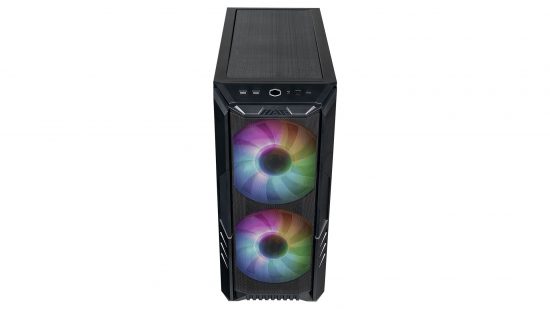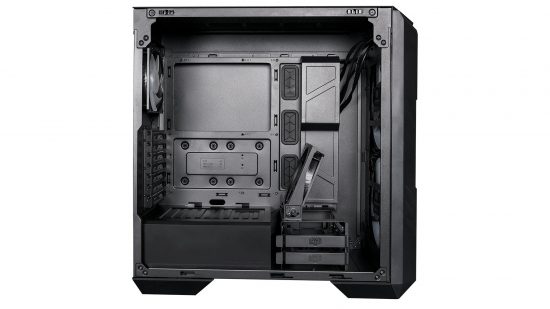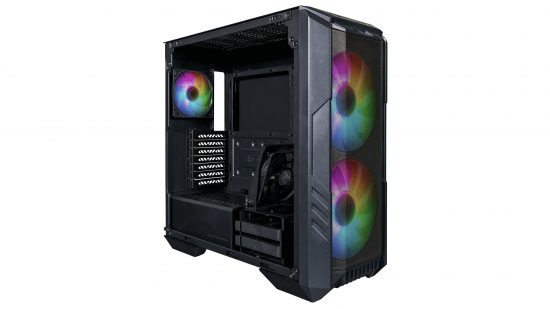Our Verdict
81%A decent feature set and solid airflow performance, but there’s a bit too much plastic on show for this price, and the cable management could be better.
Cooler Master has reached into its archive of retired trademarks and brought the HAF (High Air Flow) series back to life, with the company making a few tweaks to its H500 design to improve airflow, resulting in the Cooler Master HAF 500 we’re reviewing here. It retains the beveled front edges, an ever-present feature going back to the original HAF cases, but this time with a more traditional flat roof.
The I/O panel sits atop the front on a sloped platform and is well-equipped, with two USB 3.0 ports, a USB Type-C port, a combined audio jack, and a power button in the shape of the cooler master logo. Meanwhile, what would usually be the reset button is set up to control the RGB lighting on the fans through the included controller. There’s also a small HAF logo below the front I/O panel, but it’s easily missed.
You can also completely remove the new featureless roof section, which gives you great access to the main chamber for installing the bulk of the hardware in your build. The power supply shroud can be removed as well, although this part is entirely made from plastic, as are the front panel and case feet, and it doesn’t feel like quality material. The whole case, in fact, for all its feature-crammed spec list, does feel like a cheaper case. It’s plenty sturdy enough, but it’s a bit light and the finishes aren’t pleasing to the touch. Even the power button makes the whole case ring with a harsh plink-plonk.

Meanwhile, the PSU shroud only covers approximately half of the case floor, as there’s a hard drive cage in this area. While this isn’t unusual in itself, Cooler Master has added a 120mm fan to the top of the cage that can be pivoted to point at the GPU. Unlike the front 200mm and rear 120mm RGB fans, here you’ll find a plain black, non-LED Sickleflow 120 fan. Sickleflow is another old Cooler Master product line and, ironically, Sickleflow fans originally launched as LED fans. It seems out of place for this one not to have RGB lighting.
There’s enough room for a 60mm-thick 360mm radiator in the front without removing the hard drive cage, and the roof can also take up to a 360mm radiator. You can even fit a 120mm radiator to the GPU fan mount as long as you can sneak it under your graphics card.
Interestingly, the roof also has mounting holes for 200mm fans. Sadly, though, any ideas about dual 400mm radiators were dashed upon discovering that the thinnest 200mm radiator available is a 45mm-thick Alphacool model, which would clash with the motherboard.
The hard drive cage itself will take two 2.5/3.5 inch drives. The trays are tool-less and have vibration dampening for the 3.5 inch drives, and there are two further 2.5 inch drive mounts at the back of the motherboard, also with substantial dampening washers.
Cable management should be easy in this case, as there’s at least 25mm of depth in the rear and plenty of cable-tie points. However, in practice, this isn’t the case. Because of the way the PSU shroud is mounted to the motherboard tray, there’s just one small, single pass-through below the motherboard in the center, which makes it awkward to route and tie down the front panel cables (as well as chunky graphics card cables).
The front I/O panel and fan cables also can’t be completely hidden or tucked out of sight, with a large chasm for the cables to cross to reach your motherboard – there’s a cable bar to hide some of them, but you can still see a good few centimeters of them in the corner.
The top half of the cable bar (where it won’t foul graphics cards) increases the clearance from 18mm to 32mm, allowing for thick 24-pin cables. It’s just a shame that it only covers the additional pass-throughs for EATX cables, leaving the ATX pass-throughs and grommets in plain sight. Having just one set of pass-throughs and grommets behind the bar would have looked much cleaner.
There’s also a lack of routing holes above the motherboard. You have one in the rear corner for the exhaust fan and 12V EPS cables, then a second smaller hole on the near side corner of the motherboard. There really ought to be one in the middle, as this is almost always where CPU fan headers are located.

Cooler Master HAF 500 cooling performance
Unsurprisingly for a case with only one layer of mesh per panel, the HAF 500 performs exceptionally well. With the fans running at maximum speed, the CPU delta T was just 66°C and the GPU delta T was just 44°C.
It’s a little noisy at full speed (41.2dBA), but not obnoxiously so. At 35dBA the case still performs really well, being only beaten by the 4000D Airflow in our recent case tests. The dedicated GPU fan is actually functional and not just a gimmick too, with the GPU temperature rising by 7°C when we removed it.
| Cooler Master HAF 500 temperature results | |
| Max speed CPU delta T | |
| Cooler Master HAF 500 | 66°C |
| Corsair iCUE 5000T RGB | 66°C |
| Corsair 4000D Airflow | 77°C |
| Max speed GPU delta T | |
| Cooler Master HAF 500 | 44°C |
| Corsair iCUE 5000T RGB | 46°C |
| Corsair 4000D Airflow | 47°C |
| 35dBA CPU delta T | |
| Corsair 4000D Airflow | 69°C |
| Cooler Master HAF 500 | 70°C |
| Corsair iCUE 5000T RGB | 71°C |
| 35dBA GPU delta T | |
| Corsair 4000D Airflow | 47°C |
| Cooler Master HAF 500 | 48°C |
| Corsair iCUE 5000T RGB | 50°C |
The likely reason for that dedicated GPU fan, though, is the 200mm intakes. While they can shift a large volume of air, their low static pressure denies them good penetration into the case, although they do look impressive behind the mesh front panel. As an experiment, we switched them out for three be quiet! 1,700rpm Light Wings fans and removed the GPU fan, and we got the same GPU temperature result as the stock setup.
Cooler Master HAF 500 pros and cons
Pros
- Good cooling
- Great air and water-cooling support
- Elegant design
Cons
- Basic accessories and features
- No USB 3.2 Gen 2 Type-C support
- Limited cable stowage
Cooler Master HAF 500 specs
The Cooler Master HAF 500 specs list is:
| Dimensions (mm) | 224 x 516 x 510 (W x D x H) |
| Material | Steel, plastic, glass |
| CPU cooler clearance | 167mm |
| Max graphics card length | 410mm |
| Weight | 9.5kg |
| Front panel | Power, reset, 2 x USB 3, 1 x USB 3.2 Gen 2 Type-C, 1 x stereo/mic jack |
| Drive bays | 2 x 2.5″, 2 x 2.5/3.5″ |
| Form factors | Mini ITX, micro-ATX, ATX, SSI CEB, E-ATX (305 x 358mm) |
| Available colors | Black, white |
| Cooling | 3 x 120mm/2 x 140mm/2 x 200mm front fan mounts (2 x 200mm ARGB fans included), 1 x 120mm rear fan mount (120mm ARGB fan included), 3 x 120mm/2 x 140mm roof fan mounts (fans not included), 1 x 120mm GPU fan mount (120mm Sickleflow fan included) |
Cooler Master HAF 500 price
The Cooler Master HAD 500 price is $165 / £145 at the time of review, making this a premium ATX PC case.
Price: Expect to pay $165 / £145
Cooler Master HAF 500 review conclusion
The HAF 500 promised a lot on paper, and while it doesn’t always deliver the quality you’d expect from a $165 case, there’s a lot of additional features and performance for the most demanding of systems, whether you’re cooling with air or water.
Cable management was a let down when it comes to passthroughs, but at least there’s a cable bar. Meanwhile, the GPU fan makes up for the lack of oomph from the front intake fans without adding too much noise. This is a good case, but it could have been great if it weren’t let down by a few iffy design choices and a tightly squeezed bill of materials. For our pick of the finest PC cases, check out our best PC case list.
